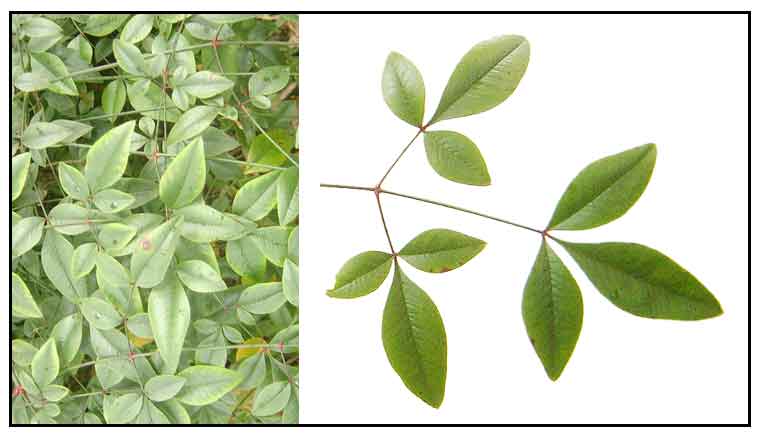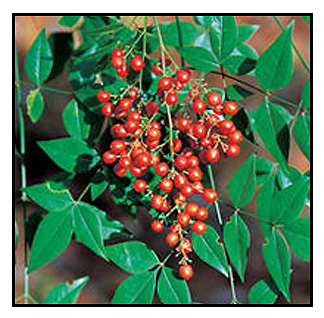| 
Gen info
- Etymology: Nandina derives from the Japanese name, nanten. Domestica means 'domesticated' or 'of the househoold.' (24)
Botany
Despite its name, Nandina is not a bamboo. It is an evergreen shrub growing to 2.5 meters high, with numerous unbranched stems growing from the roots. Leaves are 2- to 3-pinnate, with narrow leaflets up to 5 centimeters long, pink to red before turning green. Flowers are small, white, in panicles, up to 30 centimeters long. Fruit is a bright red or purplish berry, each containing 1 to 3 seeds.
 Distribution Distribution
- Recently introduced to the Philippines.
- Still rare in cultivation.
- Native to Asia, occurring in India, Japan, and China.
Constituents
• Berries contain alkaloids such as nanterine, used in research as an antidote to MDMA.
• All parts of the plant are poisonous, containing hydrocyanic acid, and can be fatal if ingested.
• Study has isolated an alkaloid, nantenine, with ability to block chemically induced head-twitching in mice.
• Roots yield domesticine, O-methyl domesticine(nandinine), nandazurine, berberine, jatrorrhizine. The stem yields domesticine, O-methyl domesticine, berberine, jatrorrhizine, magnoflorine, menispermine, nandinine, isoboldine, nandazurine, dehydronandinine, sinoacutine, N-nornandinine, hydroxynandinine, nuciferine, dehydroisoboldine, palmatine, coptisine, columbamine, thalifendine, thalidastine, 5- hydroxy berberine, epiberberine, groenlandicine.
• Study isolated a tyrosinase-inhibiting compound, 4-ß-D-glucopyranosyloxybenzoic acid. (see study below) (5)
• Study of seeds yielded several lignans identified as
syringaresinol (1), pinoresinol (2), medioresinol (3), 1-hydroxypinoresinol (4), gentioluteol (5), berchemol (6), berchemol-4'-O-β-D-glucoside (7). (14)
• Study of seeds yielded nine phenolic compounds: syringic acid (1), ethyl gallate (2), ellagic acid (3), caffeic acid (4), p-hydroxybenzoic acid (5), gallic acid (6), protocatechuic acid (7), 3, 3'-di-O-methylellagic-4-O-β-D-glucoside (8), and bergenin (9). (16)
- Study of fruit isolated a new steroidal alkaloid, (20S.22R.24R)-24-ethyl-3-oxocholest-4-en22 amino, named nandsterine (1), along with 10 known alkaloids, palmatine (2), O-methylbulbocapninr (3), nantenine (4), dehydronantenine (5), glaucine (6), didehydroglaucine (7), dehydrocorydaline (8), jatrorrhizine (9), magnoflorine (10) and berberine (11). (see study below) (25)
Properties
- Reported toxicity of all plant parts.
-
Studies suggest antifungal, antioxidant, tyrosinase inhibitory, antibacterial, radical scavenging, antiasthma, anti-inflammatory properties.
Toxicity
- Cyanide toxicity / Berries / All Plant Parts: The berries contain cyanogenic glycosides that liberate hydrogen cyanide when damaged. Poisoning as also been reported in cats and dogs, cautioning against consumption of all plant parts, including leaves, stems, and berries. (see study below) (7) (17) (21)
Parts utilized
Roots, leaves, and fruits.
Uses
Folkloric
- No reported medicinal folkloric use in the Philippines.
- In Chinese medicine, dried berries used for cough. Also, tonics are derived from the bark and root-bark are used for eye conditions, flu, muscle pain, rheumatism, gastrointestinal maladies and fever.
- Fruit used for cough, asthma, whooping cough, malaria, and penile ulcers.
- In Japan, fruit used to treat cough and breathing difficulties.
- In Chinese and Japanese traditional medicine, fruits used for treatment of tumors and tooth abscesses.
Studies
• Antifungal:
Study of oil and extracts revealed antidermatophytic effect against Trichophyton rubrum, T mentagrophytes, Microsporum canis. Results suggest that N domestica mediated oil and extracts could be a potential source of natural fungicides to control certain important dermatophytic fungi. (2)
• Nantenine / Adrenergic Pressor Inhibition: Nantenine isolated from Nandina domestica showed it has antagonistic activities on a1-adrenoreceptors, a2-adrenoreceptors and 5-HT2A receptors in pithed rats. (3)
• Cyanogenic Glucoside: Study isolated a new cyanogenic glucoside, p-glucosyloxymandelonitrile, in the young shoots of N domestica. The amount of cyanogen varies from 10-20% of dry weight in young shoots. (4)
• Tyrosinase Inhibitory Activity: Study investigated the extracts of 53 parts of 36 plants species for tyrosinase inhibitory activity. The extract of Nandina domestica showed potent activity attributed to a known compound 4-ß-D-glucopyranosyloxybenzoic acid, revealed to have tyrosinase inhibiting activity for the first time. (5)
• Radical Scavenging: Study to determine free radical scavenging activity of leaf extracts showed N domestica to be among those with the highest IC50 values. (6)
• Cyanide Toxicity from Berries: Study reports of cyanide toxicity in Cedar Waxwing birds attributed to ingestion of N. domestica berries. In 2009, dozens of Cedar Waxwings were found dead. All the birds had pulmonary, mediastinal, and tracheal hemorrhages. Intact and partly digested berries were the only food found in the GI tract of the birds. Nandina berries contain cyanide and other alkaloids extremely poisonous to animals. (8)
• Nantenine / Potential MMDA (Ecstasy) Hyperthermia Antidote: Nantenine has been isolated from Nandina domestica. It has been shown to effect both the serotonin and epinephrine neurotransmitter systems and calcium channels. Studies suggest a potential for use in people who develop high fever with Ecstasy overdose. (9) (±)-Nantenine displayed high affinity and selectivity for the α1A adrenergic receptor among several other receptors suggesting that this α1 subtype may be significantly involved in the anti-MDMA effects of the enantiomers. (10) Study on the compound's chemical structure suggested it may be neurobiological activity. Nantenine, like MDMA might bind in the brain to serotonin and a1--adrenergic receptors, and block MMDA from occupying those sites and causing destructive changes. (19)
• Higenamine / Tracheal Relaxation: A crude extract has been shown to inhibit histamine- and serotonin-induced contraction of isolated pig trachea, an effect that was not explained by nantenine. Study yielded a major constituent from the most active sub fraction, higenamine, a benzyltetrahydroisoquinoline alkaloid. Results indicate that higenamine was the constituent responsible for the tracheal relaxation through stimulation of ß-2 receptors. (11)
• Biphasic Tracheal Relaxation / Comparative Effects of Higenamine and Nantenine: Results suggest a NDE relaxes the trachea quickly through ß-adrenoceptor stimulation by higenamine and slowly through Ca(2+) antagonism by nantenine. (12)
• Antibacterial / Antiasthma / Leaves: Study evaluated the antibacterial and antiasthmatic effects of Nandina domestica leaf extract. In a guinea pig model of asthma, the extract alleviated animal allergy and asthma. Extracted alkaloids inhibited gram-positive bacteria and prevented asthma, while flavones inhibited gram-negative bacteria. The extract showed no toxic effect on mice. (15)
• Poisoning in Cats: Nandina is a popular landscaping plant and presents a risk poisoning in cats. Poisoning is caused by ingestion of any portion of the plant, including roots, stem, leaves, and pollen. This blog page describes symptoms and diagnostic clues. Treatment is prevention of further consumption and administration of cyanide antidote as soon as possible. Gastric lavage and oxygen therapy may be indicated in some cases. (17)
• Higenamine: Higenamine is a chemical found in several plants including aconite, asarum, lotus, Lamarck's bedstraw, sacred bamboo, and others. The product shows up in pre-workout supplements for improving athletic performance. Its use is prohibited in sports and is on the World Anti-Doping Agency (WADA) 2017 Prohibited List. It works as a stimulant, increases heart rate and heart contractions, and also relaxes some tissues of the body. Higenamine should be discontinued at least 2 weeks before surgery. While there is not enough information on safety during pregnancy and breast feeding, it should be avoided. (18)
• Caffeoyl Glucosides / Inhibition of LPS-Induced Endothelial Inflammatory Responses / Fruits: Endothelial dysfunction is a key pathological feature of many inflammatory disease. Study of fruits isolated a new caffeoyl glucoside (1) and two known caffeoylated compounds (2 and 3). The compounds were evaluated for their effects against lipopolysaccharide (LPS)-mediated endothelial inflammatory responses. Compounds 1 and 2 inhibited LPS-induced hyperpermeability, adhesion, and migration of leukocytes across a human endothelial cell monolayer in a dose dependent manner. Results suggest potential as a therapeutic agent to treat vascular inflammatory disorders. (20)
• Cancer-Related Molecular Targets / Fruits: Study of fruit extracts by UPLC-MS/MS analysis identified 22 compounds, which were forwarded to network pharmacology-based analysis. The enrichment of 5 compounds and 4 molecular targets viz. AKT1, CASP3, MAPK1, and TP53. Pathway analysis revealed enrichment of 15 cancer-related pathways including colorectal cancer, endometrial cancer and small-cell lung cancer. Network pharmacology revealed the compounds isoquercitrin, quercitrin, berberin, chlorogenic acid and caffeic acid showed strong synergistic interactions with cancer-related targets and pathways. Results suggest N. domestica constituents affect both apoptosis and Akt-signaling pathways during stages of early and intermediate adenoma through interactions with targets CASP3 and MAPK1 (ErC2) while in stages of late adenoma and carcinoma, the compounds act through p53 and ErbB signaling pathways. (22)
• Robustaflavone / Down-Regulation of Inflammatory Mediators / Fruits: Study of fruits by bioactivity fractionation for anti-inflammatory constituents isolated a biflavonoid, robustaflavone, The compound was shown to reduce the production of nitric oxide (NO), pro-inflammatory cytokine interleukin-1 beta (IL-1ß), and IL-6. It also suppressed expression of inducible nitric oxide synthase (iNOS) and cyclo-oxygenase-2 (COX-2) and down-regulated the expression of LPS-induced nuclear factor-kappa B extracellular-regulated kinases (pERK 1/2).(BF-kB) and phosphorylation of extracellular regulated kinases (pERK 1/2). It also inhibited IL-8 release in LPS-induced human colonic epithelial cells (HT-29). Results suggest therapeutic potential for inflammatory bowel disease (IBD). (23)
• Higenamine / Coclaurine / Fruits: Higenamine is a key component of Chinese traditional medicine. It is a component of Nanten-nodo-ame, a throat lozenge on the Japanese market. Higenamine is a selective ß2-agonist, a prohibited substance in the list of the World Anti-Doping Agency (WADA). MS analysis investigated the components of the throat lozenge, higenamine and coclaurine, in the urine. Estimates of higenamine and coclaurine were 2.2 ± 0.1 µg/drop and 0.5 ± 0.01 µg/drop, respectively. The maximum concentrations of higenamine and coclaurine were 0.2-0.4 and 0.3-1.0 ng/ml, respectively, at 10-12 h after administration of higenamine (nine drops). The concentration did no reach the positivity criterion of 10 ng/mL. Results suggest there is no risk of detecting unintentional higenamine doping when the WADA reporting threshold is used. (24)
• Alkaloid / Cytotoxicity against HL-60 (Human Leukemia) / Fruits: Study isolated a new alkaloid, nandsterine (1), along with 10 known alkaloids. Compound 1, a new class of steroidal alkaloid from the family Berberidaceae, exhibited cytotoxicity against HL-60 cells (human leukemia) with IC50 of 52.1 µM. (see constituents above) (25)
Availability
- Cultivated.
- Extracts, leaf powder in the cybermarket.
|






